Whenever I teach dance, or martial arts, body mechanics are a big part of the foundation that I try to build with my students. There are many similarities to the mechanics required in partner dancing to those required in swordplay. When you get into lifting and dipping your partner, the crossover starts to even more strongly resemble wrestling. Teaching a mode of movement without specifically teaching body mechanics, especially in our sedentary world, is detrimental to long-term performance and health.
This past weekend I was teaching a dance workshop on lifting. During my introduction, where I was teaching everyone how to squat properly, I told a story about how I had once had terrible knees but had been able to rehabilitate them through sword fighting — but only after I’d learned good mechanics. On a break, a student in my workshop came up to me to ask for more details on how I had gone from knee injuries to knee health, and to seek some advice for himself. Here’s the advice I gave him:
- Learn how to squat in a way that is proper for good knee health. I’ve put up a video on this topic here.
- Learn how to lift weights or kettle bells. If you’re doing the work correctly with your knees you’ll start to build the strength and support you need through this type of power generation activity.
- Make sure that you pay close attention to your mechanics in the activities of both your hobby and general life.
He told me that he already goes to the gym. He asked me if I did anything “special” to fix my knees.
My answer was that I do knee intensive martial arts; they involve lunging and squatting and pushing. In those activities, which I do a lot, I work to have correct mechanics.
He responded, “So you just do your normal exercise activities… correctly?”
“Yes.”
That is the reality of it. You may have some special strengthening exercise that helps you build strength for your knees, or your hips, or your shoulders, but if you are using those parts of your body improperly in every other area of your life, good luck making any progress.
To correct a long-term injury you need to bring awareness to the movement patterns that are supporting it and then work to correct those movement patterns at all times! Your exercise sessions are only a start, a reminder, a place to set your base. Your true training ground is every set of stairs you climb, every bus stop you stand at, every dance dip you create, and every fencing lunge you make.
Body mechanics are your life and your life is worth an investment in awareness.
